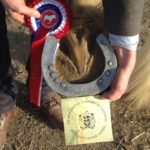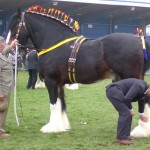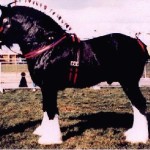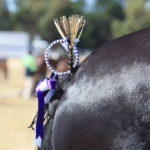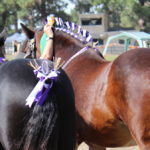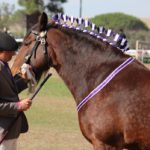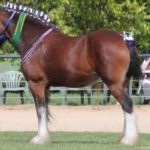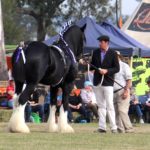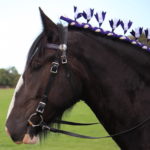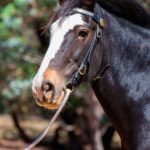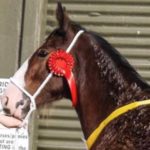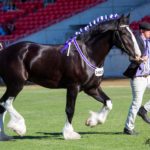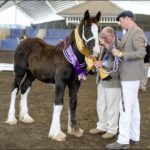SHOW PREPARATION – PRIOR TO SHOW DAY
So you’ve decided to venture into the show ring with your heavy horse – well done! Showing heavy horses is a great deal of fun. It’s all about showcasing this beautiful breed for the public, with the added benefits of exposure for both you and your horse.
To do well in the show ring, you’ll need to present your horse well. Below are a few things we recommend doing in the months/weeks before a show to get your horse looking ring ready.
Oil The Horse’s Feather
In the months leading up to show season, most successful exhibitors oil the feather and spat. That is, all of the hair on the leg below the knee. This is the best method for protecting the hair, keeping it clean and ensuring it’s in good condition.
People prefer different oils for many reasons. Paraffin oil, pig oil (paraffin sulphur mix) and even clean motor oil are all commonly used. We’ve even used coconut oil quite successfully and would recommend it or paraffin.
Wash your horse, allow the feather to dry completely and then apply oil generously. Reapply oil every two to four days. If you’d like to make sure your horse really shines, once every week to ten days bring the horse in from the paddock so you can wash the oil and dirt out of the feather, allow it to dry and apply oil again.
This process can be applied for as long as you’re prepared to do it before shows.
Paraffin oil can be purchased from most rural supply stores and coconut oil is generally better priced online in bulk.
Rug The Horse
Keeping the horse’s coat in good condition is also very important. Assuming your feed routine is sufficient, all you should need to do is put a rug on the horse for a few weeks.
Since here in Australia show season is in the hotter part of the year, a combo rug (body and neck covered) in either cotton or mesh works perfectly. The rug keeps the hair on the horse’s body short, flat and shiny.
Fitting rugs on adult heavy horses can be quite difficult. We’ve had great success using both custom rugs made here in Australia and off the shelf rugs from England. With younger horses, its usually possible to find a cost effective rug that fits well from your local horse shop.
Here’s a few places to look for heavy horse rugs:
Loretta from N’Hay Gear can make just about anything you desire. Her work is very high quality.
The Big Horse Shop sells pre made rugs designed specifically to fit heavy horses. They are reasonably priced even after the currency conversion, but the postage can be expensive.
https://www.thebighorseshop.co.uk
Love My Horse and Impressa, both based in Australia, also sell rugs in larger sizes to fit heavy horses. We have not used rugs from these companies so can’t recommend them personally, but we have heard good things from other heavy horse owners who use them.
http://www.qualityhorserugsaustralia.com.au
http://www.impressarugs.com.au
Shoe The Horse
Depending on the level you’re competing at, your horse will need to be wearing shoes. If you’re competing at a single local show and don’t normally keep your horse shod, you may decide you don’t want to go to the expense of shoeing your horse for one show. At a local agricultural show, that is acceptable as long as the horse’s feet are trimmed and in good condition. That said, you may find if two horses are on equal footing, the judge will give the award to the shod horse.
At higher levels of competition like Royal shows, horses do need to be wearing shoes.
Judges do not expect very young horses to be shod, however most would like to see shoes on the horse by the time it is three years old at the latest. At Royal shows, that might be two years of age.
A good heavy horse show shoe is a little different to a standard light horse shoe, though either are acceptable.
Heavy horse show shoes tend to be made from thicker steel to enhance the action of the horse, and have a bevelled edge that forms a nice line for the eye. See pictures below.
Practice The Things You’ll Be Expected To Do In Show Ring
We can’t stress this highly enough – it is not good form to be training your horse for show at a show!
If you’re showing in led classes, you need to make sure your horse will trot in hand. If your horse has not done this before, start training with a safe, sturdy fence beside them so they’ll naturally trot in a straight line for you. Once you’ve both got the hang of it, you can move away from the fence and keep practicing. You are looking for a nice, active working trot.
In led classes you’ll also need to get your horse to ‘stand up’ correctly so that the judge can assess it. The front feet should be evenly spaced and under the shoulder, hocks and back feet together under the rump and head up. See picture below.
If you’re showing in ridden, harness or ground driven classes, make sure that your horse has the appropriate level of training to be competing at a show.
In almost all heavy horse classes, presentation is done in the traditional way. See the section below for more information on what you’ll need.
At most shows you’ll also experience time waiting for classes ringside, so your horse will need to stand quietly and patiently with you.
NB: All horses and handlers alike have bad days, which can’t be avoided. We are not suggesting that anything less than perfection means you’re not welcome at the show. Everyone must start somewhere. We’re simply pointing out that in the show ring should not be the first time you ask your horse to do something!
Here are a few examples of horses standing up correctly in the show ring:
Get Your Horse Tack & Gear Ready
Heavy horses have a beautiful, traditional way of being presented at shows that will require some preparation. Shires are presented with the mane plaited in a ‘mane roll’ and the tail either plaited up or trimmed above hock level with a bun in the top. This is so that the judge can see the hocks and rump working as the horse moves away from them.
You’ll need decorations for your horse – you can either have a crafty day and make your own or order them online. We highly recommend Elaine from Heavy Horse Decorations in England – she makes beautiful quality traditional decorations in many colours that will last a long time if cared for well.
http://www.heavyhorsedecorations.co.uk
When it comes to decorations, there are slightly different requirements depending on the age and sex of the horse. Yearlings can be put into either category – some people include a mane roll on yearlings while others do not, the choice is yours.
Weanlings and Yearlings need:
- Neck ribbon
- Tail loop
- Tail sprigs
- Tail ribbons
Yearlings and Adults need:
- Neck ribbon
- Tail loop
- Tail sprigs
- Tail ribbons
- Mane roll
- Flights
The plaiting and presentation of a Shire is not difficult, but does require some practice. For more information on exactly what to do with decorations, please see our separate post on decorating a Shire for show.
Here’s a few pictures of Shires decorated for show:
Next, you’re going to need a bridle or halter. Most shows require colts over twelve months of age to wear a bit, but other than that the choice is yours. You can choose leather or biothane, sometimes even traditional white rope. We tend to show young horses in white biothane halters and older horses in leather bridles with brass fittings, just because that’s what we like. As long as your chosen option is clean, in good condition and isn’t the standard rope halter you’d use at home, you’ll be fine.
Here are a few pictures of different types of bridles and halters:
A good quality lead is also important! Most people use either leather or white rope leads. Our preference is white rope, simply because we prefer the feel in the hand.
You may choose to show with a cane or carrot stick. Traditional canes are made from wood with a plaited leather handle. Canes are not required equipment, but most people do use them as they’re very helpful tools. They can be used to touch the horse on the ribs if it is reluctant to trot, to tap the horse on the hock to ask it to stand up correctly or even placed in front of the nose in the trot to ensure steady pace.
Obviously, if you’re competing in ground driven, harness or saddle events you will also need the equipment you use for those classes.
Finally, you’ll need to have all of the standard horse preparation equipment on hand – food and water buckets, travel halter and lead, brushes, metal comb, hoof pick, scissors etc. Heavy horse specific items to add include wood flour, raffia, talcum powder and a platform to give you height if you need to put a mane roll in. Don’t forget to pack your registration papers if needed, and some cash for entry fees.
Get Your Handler Attire Ready
The standard handler attire in heavy horse competitions is pants, shirt, tie, jacket, hat and boots.
Pants – Most people in Australia show in either pale coloured moleskins or nice dress pants.
- Shirt – Generally a collared dress shirt is worn, though women also use dressy tops without collars.
- Tie – A tie is not always necessary, but when worn ties are often matched to the colours the horse is wearing.
- Jacket – A nice suit coat or horse specific riding jacket are the most common choices.
- Hat – The type of hat you wear is completely up to you! Akubras are very common here in Australia, but you can choose any type of dress hat you like. Just make sure it fits well enough not to blow off your head easily.
- Boots – Again, as long as your footwear is clean and in good condition, the style choice is up to you.
Below are a couple of examples of handler attire
If you have any questions please don’t hesitate phone us!
Cai – 0401476194
Em – 0401693025
